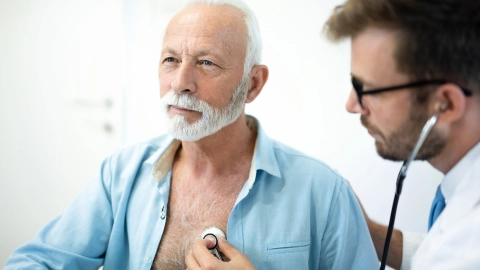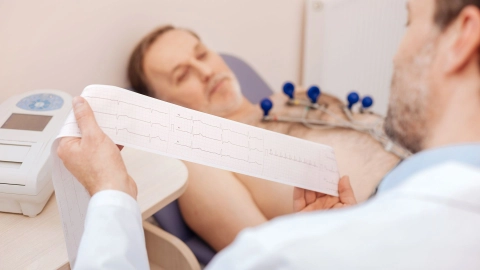Conditions Cardiac arrhythmia (heart rhythm disorder)
ICD codes: R00 What are ICD codes?
Cardiac arrhythmias are common, especially in older people and in people with other heart problems. They don’t always need treatment. If treatment is required, medication or a heart procedure will be considered.
At a glance
- The heartbeat is triggered by electrical impulses that begin in the right atrium (right upper chamber) of the heart.
- The rhythm of the heart is not entirely regular, even in healthy people. For example, people may briefly experience skipped heartbeats several times a day.
- Doctors talk of cardiac arrhythmia or a heart rhythm disorder when the heart rate is more disrupted than normal or does not match the current intensity of the person’s physical exertion.
- Cardiac arrhythmias can start suddenly and can disappear again a few seconds or minutes later.
- Some people with cardiac arrhythmias can cope without treatment.
- For others, medication, heart surgery or electrical aids such as a pacemaker help.
Note: The information in this article cannot and should not replace a medical consultation and must not be used for self-diagnosis or treatment.

What is cardiac arrhythmia?
The heartbeat is triggered by electrical impulses that begin in the right atrium (right upper chamber) of the heart. These impulses are usually sent out in a steady rhythm of around 60 to 80 beats per minute at rest. The impulses quickly spread through the heart muscle. The heart then beats slower or faster depending on the intensity of the person’s physical exertion at the time. This ensures that it always pumps enough blood through the body. However, even healthy hearts don’t have an entirely regular rhythm. Several times a day, there may be skipped heartbeats that are in fact caused by additional beats known as extrasystoles.
Doctors talk of cardiac arrhythmia or a heart rhythm disorder when the heart rate is more disrupted than normal or does not match the current intensity of the person’s physical exertion. The heart can for example:
- Beat too slowly – health professionals refer to this as bradycardia or bradyarrhythmia. A typical example is AV block, in which the transmission of impulses between the atria (upper heart chambers) and ventricles (lower heart chambers) is delayed or interrupted.
- Beat too quickly – the medical term for this is tachycardia or tachyarrhythmia. This form is also commonly referred to as rapid heartbeat or racing heart in everyday language, and it can be harmless. But tachycardia also often occurs with a serious heart rhythm disorder, such as atrial fibrillation.
- Beat irregularly – doctors call this arrhythmia, regardless of whether the heart is beating too quickly, too slowly or at a normal pace.
Sometimes several arrhythmias also occur at the same time. This means that the hearts of people with atrial fibrillation can beat too quickly and also irregularly.
Video How does the heart function?
This video provides more information about the function and role of the heart.
This and other videos can also be found on YouTube
Watch nowThe privacy policy indicated there applies.
What are the symptoms of cardiac arrhythmia?
If the heart rhythm is disrupted for a short time only, some people do not notice the arrhythmia. Others experience an irregular heartbeat as skipped heartbeats or a pounding heartbeat (both sensations are known as “palpitations”). A high heart rate can become noticeable as a rapid heartbeat (racing heart) when the heart is beating very quickly even without any physical exertion.
Most of the time, other complaints only arise when the heart rhythm is so out of step that the blood is not pumped through the body properly. If this doesn’t supply the brain with enough oxygen, it can result in dizziness or fainting.
The heart muscle itself also needs enough oxygen. If an arrhythmia causes it to be under-supplied, this can lead to chest pain, shortness of breath and weakness.
What causes cardiac arrhythmia?
A cardiac arrhythmia with a heartbeat that is too slow (bradycardia) is usually caused by an AV block, in which the transmission of impulses between the atria and ventricles is delayed or interrupted. Bradycardia can also occur if the heart’s natural pacemaker, the sinus node, fails or no longer functions correctly.
An excessively fast heart beat often occurs in conjunction with an irregular pulse in people with atrial fibrillation. Tachycardia may also be caused by atrial flutter. Another cause of rapid heartbeat is scarring in the heart.
Conditions such as atrial fibrillation, AV block or scarring usually result from heart diseases.
These include:
- coronary heart disease (CHD) and heart attack
- heart valve disease
- myocarditis (inflammation of the heart muscle)
- cardiac insufficiency (heart failure)
High blood pressure, smoking, drug consumption and also too much alcohol can also damage the heart and make cardiac arrhythmias more likely.
Other possible causes of cardiac arrhythmias are:
- an overactive thyroid
- chronic kidney disease
- diabetes mellitus
- accidents and injuries as a result of an electric current
- congenital defects present at birth, such as defects of the impulse conduction system or inherited defects in the cells of the heart
But cardiac arrhythmias can also happen in people with healthy hearts and no pre-existing conditions – these are called idiopathic cardiac arrhythmias.
Some medication can also trigger cardiac arrhythmias as a side effect. These include some blood pressure-lowering medicines and cardiac agents, anti-depressants, antibiotics or cancer medication.
How common are cardiac arrhythmias?
Cardiac arrhythmias are common, especially in older people and in people with other heart problems. People with these conditions usually also have to be treated. Younger and otherwise healthy people tend to have cardiac arrhythmias that are more or less harmless. The exceptions are genetically determined heart rhythm disorders, which are sometimes life-threatening.
Cardiac arrhythmias can start unexpectedly and can disappear again a few seconds or minutes later. Some people have these episodes repeatedly. Certain disorders can also persist.
What is the outlook for people with a cardiac arrhythmia?
Some people suddenly pass out as a result of a cardiac arrhythmia – they then run the risk of falling and injuring themselves. Cardiac arrhythmias can also cause heart failure or make existing heart failure worse.
With atrial fibrillation, blood clots in the heart may develop. If these clots dissolve, they can be washed into the brain with the blood and cause a stroke.
Life-threatening complications usually only arise when the heart is already damaged. Then cardiac arrhythmias can lead to circulatory failure, cardiac arrest or ventricular fibrillation. The heart rate is so fast that the individual heartbeats are too weak to pump enough blood through the body. If the person affected is not revived, they can die (sudden cardiac death).
How is cardiac arrhythmia diagnosed?
Cardiac arrhythmias can also be experienced as rapid heartbeat or skipped heartbeats. Sometimes when measuring your heart rate or listening to it with a stethoscope, the doctor discovers that your heartbeat is too slow, too quick or irregular.
Cardiac arrhythmias can be accurately determined and differentiated from one another through an electrocardiogram (ECG). If the ECG is normal when a cardiac arrhythmia is suspected, the problem may only occur occasionally or only during physical exertion. To be on the safe side, a 24-hour ECG or an exercise ECG is often performed.
Other tests can also be a good idea to clarify the causes or complications of cardiac arrhythmias. Heart failure can be determined by performing an ultrasound scan of the heart (echocardiogram or “echo test”), for example.
How is cardiac arrhythmia treated?
Whether and how cardiac arrhythmia is treated will depend on several factors:
- the type of the problem
- the causes and whether they can be fixed
- the severity of the problem
- whether the problem causes symptoms
- the risk of complications such as a stroke or ventricular fibrillation
The treatment of cardiac arrhythmias can vary widely:
Some patients can cope without treatment. With others the cardiac arrhythmia can be stabilized with medication. Treatment with electric shocks (cardioversion) may be required in order to normalize the heart rhythm.
Heart procedures such as catheter ablation may also help – this involves targeted destruction (ablation) of the tissues in the impulse conduction system responsible for triggering the cardiac arrhythmia. If the heart rhythm has to be permanently assisted, electrical aids such as a pacemaker or a defibrillator are options to consider.
It can be difficult to weigh up the various treatment options for heart rhythm disorders. It may be helpful to complete a decision aid in this case.
What is life like with cardiac arrhythmia?
People with cardiac arrhythmias can have symptoms such as weakness and difficulty breathing. They often have less stamina and require help with daily tasks. Sometimes the treatment can also be a burden – for example, if blood-thinners have to be taken regularly due to atrial fibrillation. The everyday life of people who have been fitted with a pacemaker or defibrillator is also restricted.
- Al-Khatib SM, Stevenson WG, Ackerman MJ et al. 2017 AHA/ACC/HRS Guideline for Management of Patients With Ventricular Arrhythmias and the Prevention of Sudden Cardiac Death: Executive Summary: A Report of the American College of Cardiology/American Heart Association Task Force on Clinical Practice Guidelines and the Heart Rhythm Society. Circulation. 2018 Sep 25;138(13):e210-e271.
- European Society of Cardiology (ESC), Association for European Paediatric and Congenital Cardiology (AEPC). Guidelines for the Management of Patients with Ventricular Arrhythmias and the Prevention of Sudden Cardiac Death. Eur Heart J 2015; 36(41): 2793-2867.
- Glikson M, Nielsen JC, Kronborg MB et al. 2021 ESC Guidelines on cardiac pacing and cardiac resynchronization therapy. Europace. 2022 Jan 4;24(1):71-164.
- Hindricks G, Potpara T, Dagres N et al. ESC Scientific Document Group. 2020 ESC Guidelines for the diagnosis and management of atrial fibrillation developed in collaboration with the European Association for Cardio-Thoracic Surgery (EACTS): The Task Force for the diagnosis and management of atrial fibrillation of the European Society of Cardiology (ESC) Developed with the special contribution of the European Heart Rhythm Association (EHRA) of the ESC. Eur Heart J. 2021 Feb 1;42(5):373-498.
- Kasper DL, Fauci AS, Hauser SL et al. Harrison's Principles of Internal Medicine. New York: McGraw-Hill; 2015.
- Menche N (Ed). Biologie Anatomie Physiologie. Urban und Fischer: München 2016.
- National Institute for Health and Care Excellence (NICE). Atrial Fibrillation: the management of atrial fibrillation. Clinical guideline – Methods, evidence and recommendations. 06.2014. Aufgerufen am 03.02.2023.
- Pschyrembel Online. 2022. Aufgerufen am 03.02.2023.
- Schmidt R, Lang F, Heckmann M. Physiologie des Menschen: mit Pathophysiologie. Springer: Berlin 2017.
In cooperation with the Institute for Quality and Efficiency in Health Care (Institut für Qualität und Wirtschaftlichkeit im Gesundheitswesen – IQWiG).
As at:





